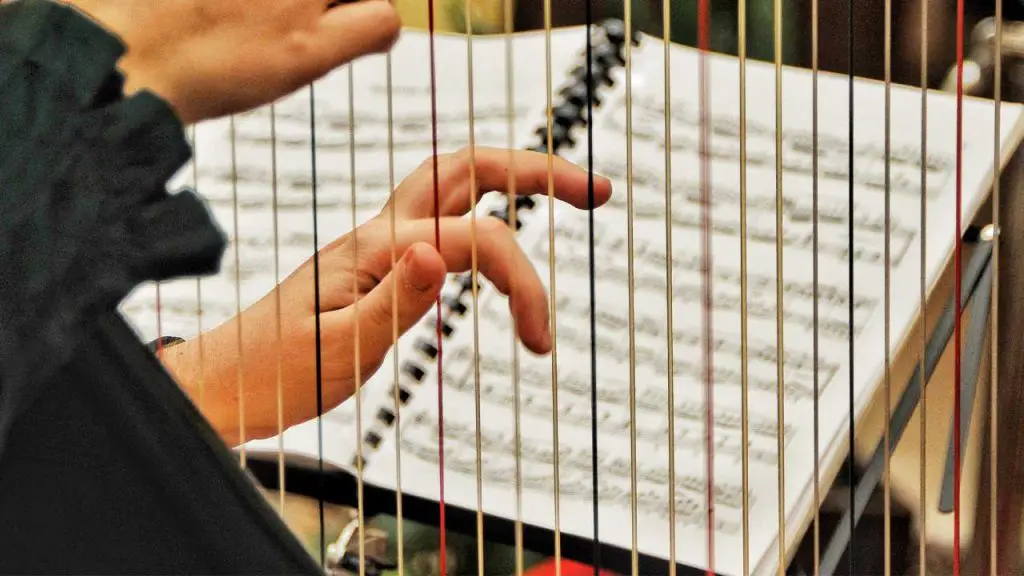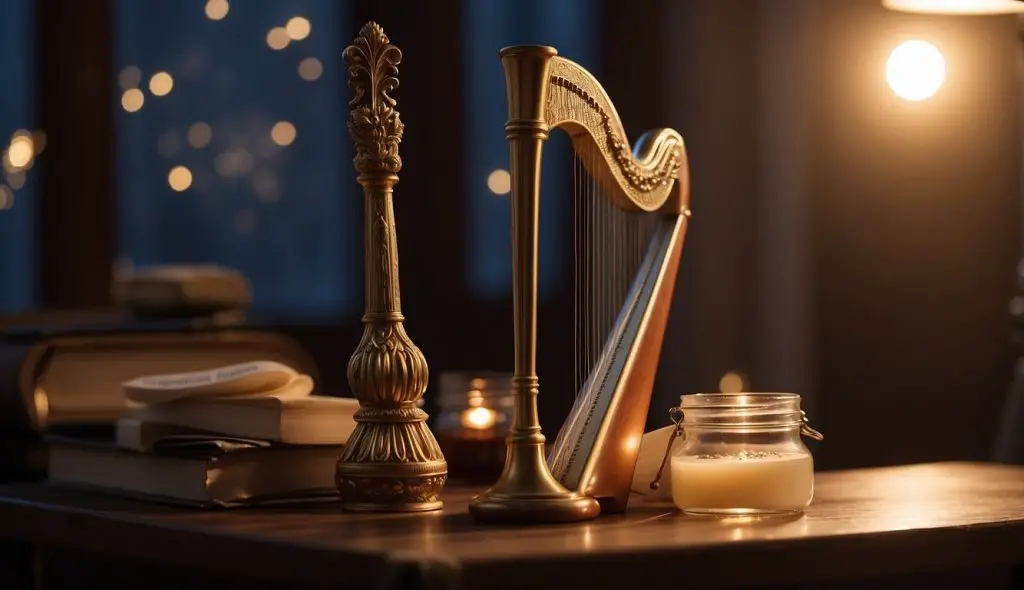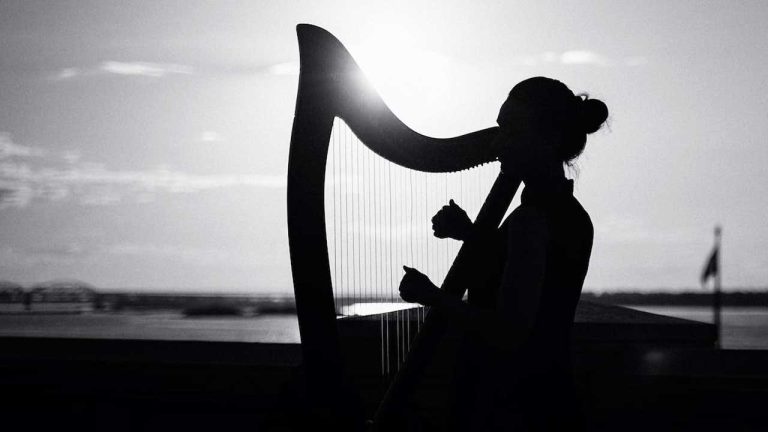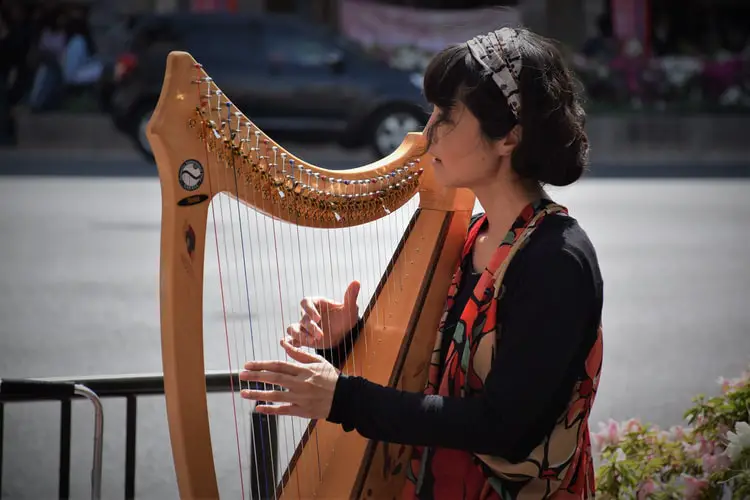Does Playing the Harp Give You Calluses? Exploring the Musician’s Journey
Folkstrings.com is reader-supported. When you buy through links on our site, we may earn a small commission.
Playing the harp is a physical and musical challenge. When I first began to learn the instrument, I quickly learned that developing calluses on my fingers was part of the process.
The harp’s strings are often made from nylon, gut, and metal. They need a fair bit of fingertip pressure to produce the desired tones. Over time, this pressure results in the formation of calluses.
Calluses serve as a protective layer for a harpist’s fingertips against the strain of plucking or strumming the strings.

As with learning any string instrument, practice is crucial, and this is true for the harp as well.
The more I played, my fingers became accustomed to the tension of the strings and the repetitive motion necessary to draw out the harp’s ethereal sounds. This frequent practice not only improved my skill but also led to thicker calluses. They are not an ailment but a necessary adaptation for harpists, helping to prevent blisters and soreness that could hinder the ability to play.
Key Points
- Calluses form as a natural response to playing the harp and are protective.
- Regular practice on the harp is necessary for skill improvement and callus development.
- Proper maintenance of the harp and ergonomic techniques are critical for effective playing.
Table of Contents
Getting Started With the Harp
When I first began learning the harp, I quickly realized that the journey starts with selecting the appropriate instrument, mastering the initial technique, and understanding the basics of harp music notation. Here’s a friendly guide to help you get started on the right note.

Choosing the Right Harp
My quest for the perfect harp began with a choice between lever harps and pedal harps. As a beginner, I found lever harps to be more accessible and affordable, which made them a great option to rent or buy for my initial practice. The pedal harps, with their extended range and ability to easily change keys, seemed more suitable for advanced repertoire and professional scenarios.
- Rent vs Buy:
- Renting a harp can be a cost-effective choice as you’re starting, giving you the flexibility to explore without a significant initial investment.
- Buying a harp is a long-term investment. Before purchasing, I made sure to research different types of harps to find one that matched my budget and learning goals.
Basic Hand Position and Technique
Mastering the harp requires the development of a proper hand position. During my lessons, I learned to keep my fingers relaxed and let them curve naturally, allowing for a smooth pluck of the strings. This technique not only helps to produce a clear sound but also helps to prevent excessive callus formation on my fingertips over time.
- Fingernails: It’s important to keep my nails trimmed; long nails can interfere with playing and may damage the strings.
- Practicing: Initially, moderate practice helps to build the necessary calluses without causing discomfort or injury to the fingers.
Learning to Read Music for Harp
Reading music is a fundamental skill for any harpist. I started by learning the treble clef (for my right hand) and bass clef (for my left hand), which form the grand staff used in harp music. Here are some basics I picked up:
- Notes and Timing: Understanding the value of each note and rest was crucial for controlling the rhythm of my pieces.
- Harp Notation: Harp music often includes annotations for lever or pedal changes, which I incorporated into my reading early on to ensure a smoother learning curve.
Practicing the Harp

When I practice the harp, I focus on establishing a solid routine and overcoming the usual challenges that come with the instrument, such as developing calluses and managing tension.
Developing a Practice Routine
I’ve discovered that consistency is key to making progress on the harp. My routine includes:
- Daily practice sessions: I aim for at least 30 minutes per day, as it helps with muscle memory.
- Patience and gradual increases: To avoid injury, I gradually increase my practice time.
- Varied repertoire: I keep practice fun by mixing technical exercises with pieces I enjoy.
- Utilizing resources: YouTube videos serve as a great tool for visual learning and tips from experienced harpists.
Overcoming Common Challenges
Playing the harp doesn’t come without its hurdles:
- Calluses: In the beginning, as my fingers toughened up, practice could be uncomfortable, but developing calluses was necessary for endurance and sound.
- Tension: I learned to remain relaxed during practice to avoid tension, which can lead to poor technique and even injury.
- Skill and hard work: These are inevitable aspects of learning an instrument like the harp, but the joy of playing well is a rewarding payoff for the effort.
Harp Maintenance and Tuning
Playing the harp not only demands skill but also requires regular maintenance to ensure the instrument produces the correct sound. Let’s focus on how I keep my harp in tune and when I know it’s time to replace the strings.
Tuning Your Harp
When I tune my harp, I make sure it is initially set in E-flat major, which allows for the greatest flexibility when adjusting for different keys using pedals or levers. I begin by using a tuning key, carefully adjusting each string to match the pitch provided either by an electronic tuner or a tuning fork.
- Pedal harps: To tune, I press down on the pedal to set it to a flat position, ensuring that the strings are not sharpened by the mechanism.
- Lever harps: I check that the levers are disengaged before tuning each string so they don’t interfere with the pitch.
I recommend checking the tuning regularly, especially before practicing, to maintain the harp’s sound quality.
Replacing Harp Strings
The harp strings can affect the instrument’s sound just as much as its tuning. Replacing harp strings is a task I perform as needed—usually evident when a string sounds dull or has obviously frayed.
- Remove the old string: I loosen the tuning peg and then remove the old string.
- Insert the new string: I thread the new string through the eyelet and tuning peg, then wind it snugly.
- Fine-tuning: Once the string is replaced, it often stretches and requires fine-tuning for a few days until it settles.
A broken string doesn’t necessarily indicate poor maintenance, but rather it is a natural outcome of regular use. I ensure that I have a full set of replacement strings on hand to avoid disruptions to my playing.
Understanding Harp Ergonomics

As a harpist, I know how crucial it is to understand ergonomics to play comfortably and avoid injuries. Proper hand positioning and technique can ward off unnecessary strain and skin damage.
Minimizing Hand and Finger Strain
When I position my hands on the harp strings, I ensure that my fingers are curved comfortably, with my thumb pointing upwards and slightly bent. This allows for a natural plucking motion that minimizes the risk of strain.
It’s important to avoid stretching my fingers too widely when reaching for strings, as this can lead to tension. To prevent overexertion, I frequently practice hand-stretching exercises before playing.
Preventing Calluses and Blisters
Regular playing can lead to the formation of calluses on my fingertips. While a certain level of callus development is normal and can even protect my skin from blisters, it’s crucial to manage them.
I maintain my calluses by moisturizing my hands and using fine-grit sandpaper to gently smooth any rough skin. If I notice a blister forming, I immediately assess my technique, as blisters can signal excess friction or pressure on the strings. It’s about finding the balance between toughened skin and flexibility.
Frequently Asked Questions
Playing the harp is a beautiful experience, but it often comes with the concern of developing calluses on my fingers.
Here, I’ve gathered some frequent questions about managing and understanding calluses related to harp playing.
How can I prevent calluses when playing the harp?
I prevent calluses by keeping my hands moisturized and using techniques that minimize unnecessary pressure on the strings. It’s also helpful to gradually increase playing time to allow my skin to adapt without overstraining.
What type of pick or plectrum should be used for playing the harp?
Traditionally, I don’t use a pick or plectrum for playing the harp because the instrument is designed for finger plucking. This allows me to maintain direct contact with the strings for a more nuanced performance.
Are there specific techniques to reduce finger discomfort while playing the harp?
Yes, I use specific hand positions and plucking techniques to reduce discomfort. Concentrating on relaxed movements and avoiding excessive force helps me prevent unnecessary strain on my fingers.
Do professional harpists experience finger pain or calluses?
Professional harpists, like myself, do indeed experience finger calluses as a result of frequent playing. These calluses are typically considered a normal part of a harpist’s development, providing protection against the strings’ tension.
How does the frequency of playing the harp affect finger health?
The more often I play, the more my fingers are subjected to the strings, which can lead to calluses. However, playing frequently with proper technique is important for building finger strength and resilience.
What are the best practices for hand care for harp players?
I believe the best practices include keeping my hands clean and moisturized. I also suggest using warm-ups to prepare my fingers before playing. Lastly, giving my hands adequate rest after long sessions can help prevent overuse injuries.
Author Profile
-
Daniel Johnstone is an English writer with a love for stringed instruments from around the world.
He shares his love for these instruments through his writing for folkstrings.com, a website dedicated to all things related to folk string music.
Daniel's passion for music started at a young age, and he has since become an accomplished musician, playing guitar, cavaco, and recently, the harp.
His dedication to learning and sharing his knowledge of stringed instruments is evident in his insightful and engaging blog posts. Whether you're a seasoned musician or a beginner, Daniel's writing is sure to inspire and entertain you.
When he's not playing music or writing, you can find Daniel exploring new instruments and seeking out new sounds to share with his readers.
Latest entries
 AutoharpApril 4, 2024What Is the Autoharp Made Of: Exploring Its Materials and Craftsmanship
AutoharpApril 4, 2024What Is the Autoharp Made Of: Exploring Its Materials and Craftsmanship AutoharpApril 4, 2024Is Autoharp Easy to Play? Unveiling the Truth for Beginners
AutoharpApril 4, 2024Is Autoharp Easy to Play? Unveiling the Truth for Beginners AutoharpApril 4, 2024What Is an Autoharp Worth? Your Guide to Pricing and Value
AutoharpApril 4, 2024What Is an Autoharp Worth? Your Guide to Pricing and Value AutoharpApril 4, 2024Are Autoharp and Zither the Same Thing? Unraveling String Instrument Myths
AutoharpApril 4, 2024Are Autoharp and Zither the Same Thing? Unraveling String Instrument Myths
Affiliates:
This post may contain affiliate links that at no additional cost to you, the site may earn a small commission. We only recommend products we would use ourselves and all opinions expressed on this site are our own.
Accuracy Advice:
While we strive to provide up-to-date and accurate information, the content in this article may not reflect the most current research or medical guidelines. We encourage readers to do further research and consult with professionals for more personalized advice.
Our Recommendations:
The products and services mentioned in any of our articles are recommended based on our independent research and personal experience. We are not sponsored by any company. We aim to suggest products and services we believe are of high quality and could be beneficial to our readers.


